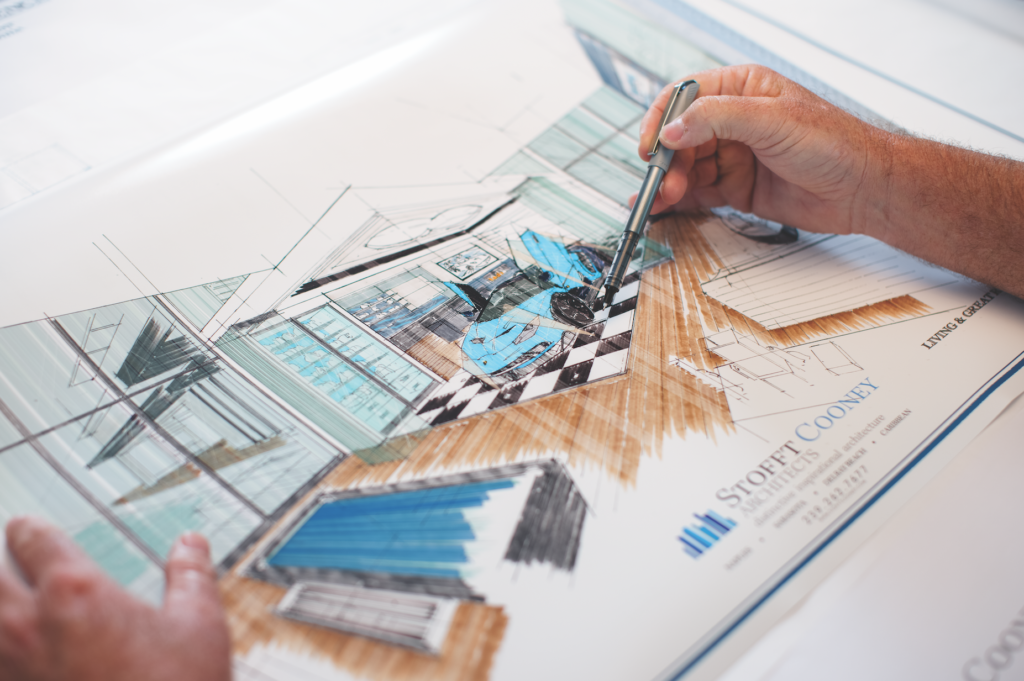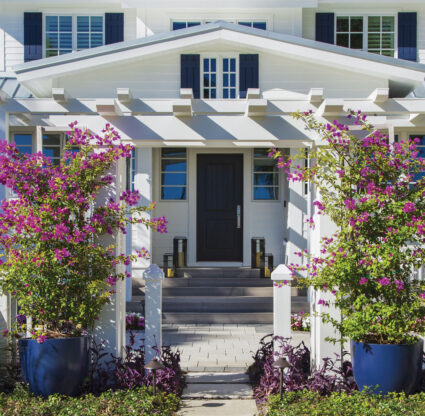For the better part of 70 years, Southwest Florida has been a chameleon, architecturally speaking. Depending on the current tastes and trends, our homes reflected our outward aspirations: from midcentury ranches in the ’50s and ’60s to the contemporary moods of the ’70s and ’80s to the Mediterranean style we appropriated in the ’90s and early 2000s. Most recently, we witnessed the emergence of the modern Florida cottage, sprinkled between some West Indies-chic beach houses and modern compounds.
But as we enter the third decade of the 21st century, it seems as though our area has begun to settle into its sense of self, allowing architects and homeowners a confidence to explore their true ideals and styles without worrying about the neighbors or trends.

Randall Stofft and John Cooney, of Stofft Cooney Architects, have seen the evolution firsthand, and when they joined forces 25 years ago, they came in with talents geared specifically toward customization—unique designs that didn’t fit a particular style, such as Italianate or modern or cottage. And, it’s safe to say that the pair is currently hitting their sweet spot. “We’ve both been in Naples about 30 years and the market was a lot different back then,” Cooney says. “There were always sporadic customs in Port Royal and Old Naples, but there used to be a lot of development work in the golf course communities.”
These golf communities are filled with large homes that are beautiful, but arguably cookie-cutter. In the last five years, most of those communities have run out of room, though. Now we see the first tear-downs happening in places such as Pelican Bay and Grey Oaks.
Roughly 95% of Stofft Cooney’s work now is in South Naples: between Park Shore and Port Royal. This is where their passion lies: custom, end-user designs. Their influence is especially felt in Port Royal, where the duo is nearing completion of their 100th residence (and working on others including what is planned as the firm’s first net-zero project—a massive estate designed to be environmentally friendly through and through).
If you believe in trickle-down architecture, it’s worth paying attention. “We used to create these more formal and informal spaces, and I don’t think anybody in these markets is really living like that,” Stofft says, adding that houses are becoming more open with larger spaces and rooms that are not separated. Kitchens are now open and flow into dining areas, which flow into great rooms.
You see similar changes to the exteriors, and the size of outdoor spaces has expanded over the last decade. “Yes, you’re losing air-conditioned space, but the houses live bigger because they are using that outdoor kitchen, that outdoor living space,” Stofft says. “Now probably 1,000 square feet of outdoor living space is common, whereas before it was perhaps 300 square feet.”
The pair believe the changes stem from the fact that Southwest Florida is seeing more permanent residents, with their second home remaining out of state. That switch affects the design and the development of the area. In addition, they say people are asking more of their houses: larger entertainment areas, more spaces to watch movies, hang out, and play pool. The architects expect that this will only grow post-pandemic.

Over the years, Stofft and Cooney have also seen a shift from more classic or traditional Florida designs to ones that incorporate more tropical influences and lean heavily toward the contemporary. Clean lines and glass continue to be in vogue. And, as manufacturing and construction techniques improve, designs get sleeker—so much so that even architects known for their traditional homes are taking a more progressive approach.
For Stofft and Cooney, maintaining an office in Delray Beach helps the architects be at the forefront of newer design ideas. “The trends start on the east coast and filter over here a few months later,” Cooney says.
While those trends may not be felt as strongly on this coast, they take hold nonetheless. Tastes are more traditional in Southwest Florida, Stofft says, although the desire for more space and sense of proportion between the indoor and the outdoor is felt as keenly in Naples as, say, Boca Raton.
Florida’s climate has a strong impact on the direction of the architecture, too. If the weather is beautiful and the breezes balmy, then why not spend more time outside than in, and incorporate more glass into the plans? As time goes on, Stofft adds, design trends won’t merely take Florida’s climate into account, they will be oriented to take full advantage of it.
Today, if you look at the planning boards across their offices, the architects have a plethora of styles. Clients are looking for custom, unique pieces of architecture. “I see the future going a lot more custom,” Cooney says. “People want homes that identify with themselves and their lifestyle.”
Stofft, for his part, doesn’t believe there will be a constant style going forward. “I almost hope not,” he says.
Photography by Brian Tietz






